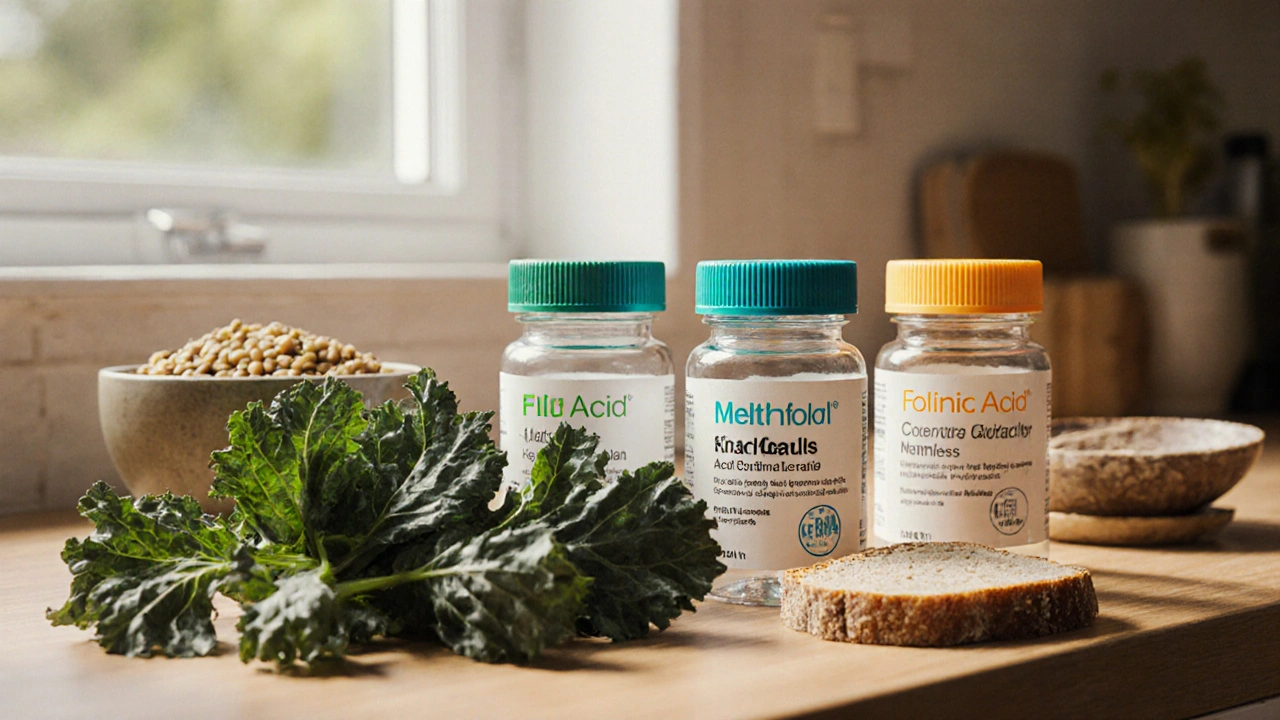Folate Supplement Selector
Your personalized recommendation will appear here after answering the questions above.
When it comes to preventing birth defects, supporting heart health, or simply staying energetic, many people reach for a folate supplement. But not all folate supplements are created equal.
Quick Take
- Folic acid is the synthetic, inexpensive form that needs conversion in the body.
- Methylfolate (5‑MTHF) is the active form, ideal for people with MTHFR gene variants.
- Folinic acid bypasses the most problematic conversion step and is favored in clinical settings.
- Pregnant women, heart‑health patients, and those on certain medications should choose carefully.
- Dosage, bioavailability, and safety profiles differ enough to affect daily intake decisions.
What Is Folic Acid?
Folic Acid is the synthetic version of the B‑vitamin folate. It’s the form you’ll find in most over‑the‑counter multivitamins and fortified grain products. Because it’s chemically stable, manufacturers can add it to foods without worrying about degradation during storage.
Once ingested, the liver converts folic acid into tetrahydrofolate (THF) and then into the active 5‑methyltetrahydrofolate (5‑MTHF) that the body can actually use. That conversion relies on the enzyme methylenetetrahydrofolate reductase (MTHFR). If that enzyme works poorly, the body may not get enough usable folate even if you take a high dose of folic acid.
Common Alternatives
methylfolate, officially called 5‑Methyltetrahydrofolate (5‑MTHF), is the naturally active form. Because it’s already “ready to go,” it bypasses the MTHFR bottleneck entirely. This makes it a popular choice for people who have a known MTHFR polymorphism or who experience fatigue despite taking standard folic acid.
Folinic Acid, also known as 5‑formyl‑THF, sits one step earlier in the conversion pathway. It can be turned into 5‑MTHF without needing the MTHFR enzyme, which is why oncologists sometimes prescribe it alongside chemotherapy to protect healthy cells.
Other related compounds often appear on supplement labels:
- Prenatal Vitamin - a blend that usually includes folic acid or methylfolate plus iron, calcium, and vitamin D.
- Vitamin B12 - works hand‑in‑hand with folate in the homocysteine‑methionine cycle.
- Iron - often combined with folate in pregnancy formulas to support blood volume expansion.
- Homocysteine - an amino‑acid marker that rises when folate or B12 is deficient, linked to cardiovascular risk.
- Neural Tube Defects - birth defects that adequate folate intake can prevent.

How the Forms Differ
Below is a side‑by‑side look at the three main folate forms. The table highlights bioavailability, conversion steps, typical dosage ranges, and the scenarios where each shines.
| Attribute | Folic Acid | Methylfolate (5‑MTHF) | Folinic Acid (5‑Formyl‑THF) |
|---|---|---|---|
| Chemical Form | Synthetic p‑aminobenzoyl‑glutamic acid | Active 5‑methyltetrahydrofolate | 5‑formyl‑tetrahydrofolate |
| Bioavailability | ~50% (requires two reductions) | ~100% (directly usable) | ~85% (one conversion step) |
| Conversion Needed | Requires MTHFR enzyme | No conversion required | Skips MTHFR, converts to 5‑MTHF |
| Typical Daily Dose | 400‑800µg (recommended for most adults) | 400‑1,000µg (often lower due to higher potency) | 400‑800µg (clinically prescribed doses) |
| Best For | General population, food fortification, budget‑friendly | People with MTHFR variants, chronic fatigue, high‑dose therapy | Oncology patients, those on anti‑folate drugs, pregnancy under medical supervision |
| Safety Concerns | High doses may mask B12 deficiency, rare unmetabolized folic acid buildup | Generally safe, but excessive intake can cause gastrointestinal upset | Well‑tolerated, but requires monitoring in chemotherapy contexts |
Choosing the Right Supplement
Here’s a quick decision tree you can run in your head or on paper:
- Do you have a confirmed MTHFR gene variant? If yes, methylfolate is usually the safest bet.
- Are you pregnant or planning to become pregnant? A prenatal vitamin that contains at least 400µg of folic acid (or methylfolate) is essential.
- Are you taking anti‑folate medication (e.g., methotrexate) or undergoing chemotherapy? Your doctor may prescribe Folinic Acid to protect healthy cells.
- Is cost a major factor? Folic acid is typically 5‑10× cheaper than the active forms.
- Do you experience unexplained fatigue or elevated homocysteine levels? Consider a trial of methylfolate under medical guidance.
Remember that more isn’t always better. The Institute of Medicine caps the upper intake level for folic acid at 1,000µg for adults because excess can hide a B12 deficiency, which may lead to irreversible nerve damage.
Practical Tips for Daily Use
- Take your folate supplement with food to improve absorption, especially for folic acid.
- If you’re on a high‑dose methylfolate regimen, split the dose (morning and evening) to reduce stomach upset.
- Combine folate with Vitamin B12 if you have a diet low in animal products; the two work together to keep homocysteine in check.
- Pregnant women should choose a certified prenatal formula that also includes Iron and calcium for bone health.
- Check the label for “unmetabolized folic acid” warnings if you’re sensitive to synthetic forms.
Potential Pitfalls
While folate is essential, misuse can cause problems:
- Excess folic acid may mask a B12 deficiency, leading to neuropathy.
- Some people experience allergic reactions to fillers in cheap generic brands.
- High‑dose methylfolate can interact with certain anticonvulsants, reducing their effectiveness.
- Folinic acid is potent; taking it without medical supervision can disrupt normal folate cycles.
If you notice persistent nausea, skin rashes, or neurological tingling after starting a folate supplement, stop and discuss with a health professional.

Frequently Asked Questions
Can I replace folic acid with methylfolate in my prenatal vitamin?
Yes, many prenatal brands now offer methylfolate instead of folic acid. It provides the same protective effect against neural tube defects and may be easier for women with MTHFR variants to absorb. Just check the dosage; most guidelines still recommend 400‑800µg of active folate per day.
What’s the difference between folate and folic acid?
Folate is the natural form found in leafy greens, legumes, and fruits. Folic acid is the synthetic, more stable version used in supplements and fortified foods. The body must convert folic acid into the active form, which some people cannot do efficiently.
Should I take a folate supplement if I already eat a lot of leafy vegetables?
If your diet includes spinach, kale, broccoli, and beans daily, you may already meet the Recommended Dietary Allowance (400µg for most adults). Blood tests for serum folate or homocysteine can confirm whether you need extra supplementation.
Can high doses of folic acid cause health problems?
Exceeding 1,000µg per day can hide a vitamin B12 deficiency, potentially leading to nerve damage. Some studies also suggest a possible link between very high folic acid intake and increased cancer risk, though evidence is not conclusive.
Is folinic acid the same as methylfolate?
No. Folinic acid (5‑formyl‑THF) is one step earlier in the conversion chain and still needs to become 5‑MTHF before the body can use it. Methylfolate is already the final, active form.
Do I need to worry about folate when taking methotrexate for arthritis?
Methotrexate works by inhibiting folate metabolism, so doctors often prescribe a low dose of folinic acid (sometimes called “rescue” therapy) to reduce side‑effects while preserving the drug’s therapeutic action.
Whether you stick with the cheap, widely available folic acid vs methylfolate debate, or you opt for a specialty product, the key is to match the form to your personal health needs. A simple blood test, a quick chat with your clinician, and a look at your daily diet can point you toward the version that offers the most benefit without unnecessary risk.


Comments (10)
Daniel Buchanan
1 Oct, 2025When picking a folate supplement, first consider your personal health factors-whether you’re pregnant, have an MTHFR variant, are on anti‑folate medication, or are watching your budget.
For the general population, inexpensive folic acid usually covers the need, but active forms like methylfolate or folinic acid are better when conversion issues or specific medical conditions are present.
Always run the choice by a healthcare professional before you start, especially if you have other meds or health concerns.
Lena Williams
1 Oct, 2025I've read a bunch of stuff on this topic and honestly it blew my mind how many people just grab the cheapest folic acid without thinking about their own metabollism.
My friend who was diagnosed with an MTHFR variant found that switching to methylfolate gave her a huge boost in energy and she said she felt more alive after just a few weeks.
On the other hand, some folks who are on methotrexate were told by their doc to use folinic acid as a rescue therapy and that can make a huge difference in side‑effects.
So yeah, the best supplement really depends on your personal situation and the doc's advice, not just the price tag.
Just make sure you read the label carefully and check the dosage because more isn’t always better.
Sierra Bagstad
2 Oct, 2025Folic acid is a synthetic p‑aminobenzoyl‑glutamic acid that requires two reduction steps mediated by the MTHFR enzyme to become the biologically active 5‑methyltetrahydrofolate.
Methylfolate bypasses this enzymatic conversion, providing 100 % bioavailability, which is particularly advantageous for individuals with MTHFR polymorphisms.
Folinic acid (5‑formyl‑THF) requires only a single conversion step, making it suitable for patients receiving anti‑folate chemotherapeutic agents.
Clinical guidelines recommend 400–800 µg of folic acid daily for women of childbearing age to prevent neural tube defects.
Excessive intake above 1 000 µg per day may mask vitamin B12 deficiency and should be avoided.
Alan Kogosowski
2 Oct, 2025The decision between folic acid, methylfolate, and folinic acid hinges on a nuanced understanding of both genetics and pharmacology, which many casual readers overlook.
People with a functional MTHFR gene typically convert folic acid efficiently, whereas those with common polymorphisms such as C677T experience reduced enzymatic activity, leading to lower intracellular 5‑MTHF levels.
In such cases, methylfolate supplementation circumvents the bottleneck entirely, delivering the active form directly to the folate cycle.
Moreover, the clinical literature demonstrates that methylfolate can reduce homocysteine concentrations more rapidly than folic acid in populations with elevated baseline levels.
Conversely, patients undergoing methotrexate therapy for rheumatoid arthritis or certain cancers benefit from low‑dose folinic acid, which acts as a "rescue" agent protecting healthy cells without interfering with the drug's anti‑folate mechanism.
The pharmacokinetic profile of folinic acid shows an intermediate bioavailability of approximately 85 %, which is higher than folic acid but still requires conversion to 5‑MTHF before participation in methylation reactions.
Cost considerations also play a significant role; folic acid is typically 5‑10 times cheaper per microgram than its active counterparts, making it the default choice for public health fortification programs.
However, the economic advantage must be weighed against the potential for unmetabolized folic acid accumulation, a phenomenon linked to altered immune function and, in some studies, an increased risk of certain cancers.
Dietary patterns further influence supplement choice: individuals adhering to vegetarian or vegan diets may have lower intake of B12, which works synergistically with folate to maintain homocysteine metabolism.
Hence, pairing methylfolate with a reliable source of methylcobalamin can optimize the methylation cycle for those on plant‑based diets.
For the average adult with no known genetic variants and a balanced diet, a daily 400 µg of folic acid satisfies the recommended dietary allowance without undue risk.
Pregnant women, however, are advised to obtain at least 600 µg of folate per day, and many prenatal formulations now incorporate methylfolate to address MTHFR concerns preemptively.
It is also prudent to monitor serum folate and homocysteine levels periodically, especially when high‑dose supplementation is contemplated.
Ultimately, the optimal folate strategy should be individualized, incorporating genetic testing, medication review, dietary assessment, and cost analysis.
Consulting a qualified healthcare professional remains the cornerstone of safe and effective folate supplementation.
Ben Lee
2 Oct, 2025Finding the right folate supplement is a bit like choosing the right tool for a specific job, and it helps to break down the options into clear categories.
Folic acid is the workhorse you see in most multivitamins and fortified foods, and it’s cheap and stable, but it does rely on the MTHFR enzyme to become usable.
If your body’s MTHFR activity isn’t optimal, you might still feel fatigued or notice elevated homocysteine despite taking the recommended amount.
That’s where methylfolate shines-it’s already in the active 5‑MTHF form, so it skips the conversion step entirely and can be more effective for people with the common C677T or A1298C variants.
Folinic acid, sometimes called “5‑formyl‑THF,” sits one step earlier in the pathway and can still become 5‑MTHF without needing MTHFR, making it a good compromise for those on anti‑folate drugs like methotrexate.
Cost is another practical factor: folic acid is the most budget‑friendly, while methylfolate and folinic acid can be several times more expensive per dose.
When you’re pregnant or trying to conceive, the safest bet is a prenatal formula that includes at least 400 µg of folate, whether that’s folic acid or methylfolate, along with iron and calcium.
For vegans or strict vegetarians, pairing methylfolate with a reliable B12 source can help keep the methylation cycle running smoothly.
In short, match the supplement to your health status, dietary pattern, and financial situation, and keep an eye on any lab values your doctor might suggest.
David Brice
2 Oct, 2025Listen up, if you’re still popping cheap folic acid while you’ve got a known MTHFR issue, you’re just wasting money and riskin your health.
Switch to methylfolate right now, it’s the only form that actually works for you, no more guesswork.
Don’t forget to pair it with B12, otherwise you’ll still feel the same fatigue and brain fog.
And for anyone on methotrexate, stop the folic acid and ask your doc for folinic acid – that’s the rescue you need.
Bottom line, get the right supplement or you’ll keep feeling crappy.
Zachary Schroer
3 Oct, 2025Only those truly versed in biochemistry appreciate the subtle superiority of methylfolate over the pedestrian folic acid 🌟 its bioavailability is unparalleled and the genomic implications are profound 🧬
Stacy Whitman
3 Oct, 2025Our country's health guidelines should prioritize cheap folic acid for everyone.
Kim and Lin
3 Oct, 2025I get that cost is a big deal for many folks, so sticking with folic acid makes sense for most people :) but if you’ve got the MTHFR gene variant you really should consider methylfolate, it’s worth the extra bucks.
Kemari Nielson
3 Oct, 2025Choose methylfolate for MTHFR variants; otherwise folic acid suffices.